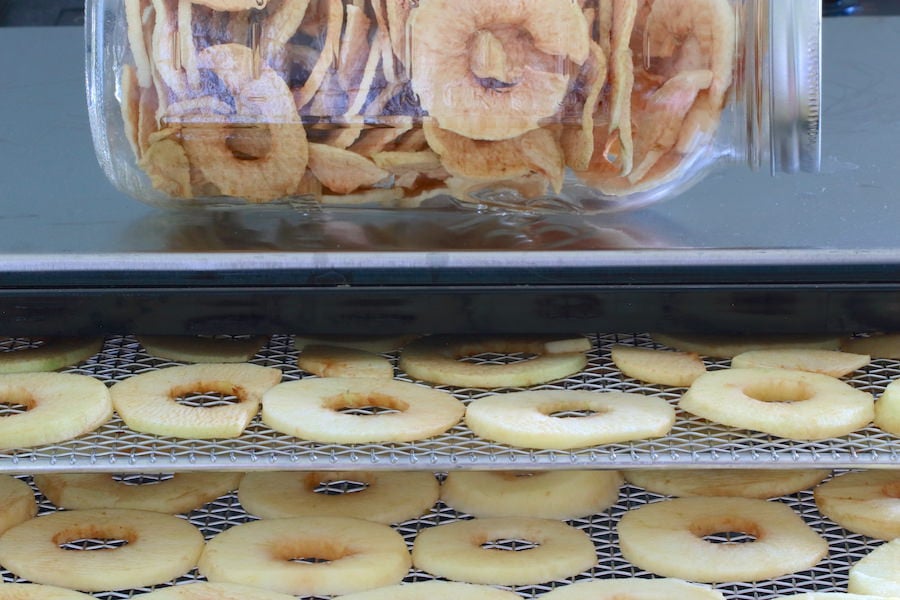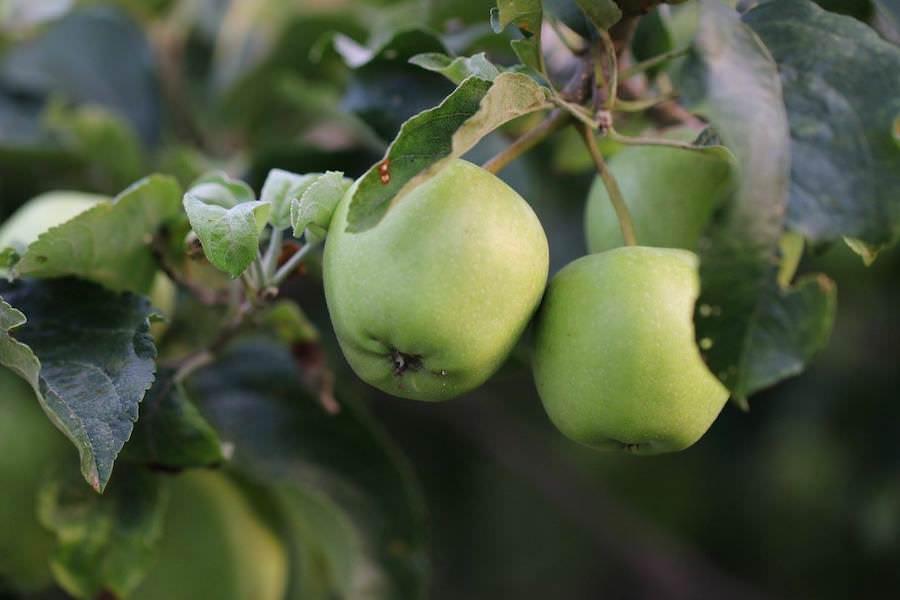Dehydrating apples is a great way to put up an abundant harvest! They’re yummy, healthy, portable, low-cal treats. Kids and adults love them – dogs can also enjoy dried apples in moderation. Break them up into small bits to use as a puppy training treat (we’re getting a new puppy next week so pups are on my mind lol).
Our apple trees produced heavily this year; I have three half-bushels picked and waiting for me to put up (and more still on the trees). I’ll dehydrate enough to fill many half gallon jars, can plenty of apple sauce, freeze slices for future pies, then cold store whatever is left.
If you don’t grow your own, Autumn is the time of year to look for organic farm stand apples. You may even have a neighbor that would be willing to sell their surplus. Some folks may be happy to give their apples away if they don’t have the time or inclination to put up their harvest.
We grow six varieties of apples. I find that all of the varieties can be dehydrated, but softer moister apples, such as Delicious, take longer to dry out.

Dehydrating Apples | Easy Method
I’ve tried various methods for drying apples, and settled on this easy routine many years ago. I prefer peeling the apples because I find that dried apple skins aren’t very pleasant. Slicing them into rings creates a more uniform thickness, which helps them dry evenly. Some folks like to pretreat the slices by dunking them in a lemon or citric acid bath before drying – but I find this step unnecessary. It is meant to keep the apples from browning, but I think they come out beautiful and dry easier without dunking them first.

Method Overview
- Wash, peel, core, and slice apples into rings
- Arrange single layer on trays
- Dehydrate at 135ºF
- Check and rotate trays periodically
- Condition, then store

Apple peeler, corer, slicer gadgets
I purchased my apple peeler, corer, slicer from Lee Valley. It has a suction cup base, which I prefer over a clamp base. It works pretty good; however, sometimes it doesn’t core and slice depending on the shape of the apple. Even so, it’s worth having one if you process a lot of apples because it reliably peels them, and does so very quickly. This article by Spruce Eats “The Seven Best Apple Peelers of 2021“, reviews several styles made by various manufacturers.
How to prepare apples by hand
If you don’t have a 3-in-1 gadget you can still prepare your apples by hand using a peeler, corer, and knife. It will just take a little longer.
Dehydrating Apples | Easy Method
Equipment
- dehydrator (or oven with very low temperature)
- tools to peel, core, slice apples
Ingredients
- apples (8 to 10 apples, when dried, will fill a half gallon jar)
- cinnamon powder, optional
Instructions
Preparing the apples
- Wash, peel, core, and slice the apples into 1/4-inch-thick rings.
- Lay them single layer on your food processor's trays.Sprinkle with cinnamon if using.
Dehydrating
- Dehydrate at 135º until the rings are dry to the touch but still a bit rubbery. The rings should not be so moist that they stick together.
- Let them cool down completely before placing them in jars with tight fitting lids. Pack them loosely at this point.
Conditioning
- Shake the jars and observe the dried apples every day for about a week to make sure no moisture develops on the glass and to be sure the apples slices aren't sticking together. If this happens, there is moisture in the jars and the apples should be put back into the dehydrator.
- After conditioning, you can pack the jars fuller. Store them in a dark, cool, dry space.
Notes
- Use fully ripened apples. Drying apples will not make them taste better, so don’t use old or underripe fruit. Apples that show decay, bruises, or mold should not be used.
- If you prefer crunchy dried apple “chips,” leave them in the dehydrator longer until brittle.
Factors that effect dehydration time
In general, it takes somewhere between 8 to 10 hours for 1/4-inch-thick apple rings to dehydrate. The actual time will depend on several factors, such as:
- temperature of the dehydrator
- humidity in the room
- whether the dehydrator has a circulating fan or not to keep the heat evenly distributed
- how often the dehydrator is opened, and if it opens from the top or side
- moisture level of the apples to begin with
- whether you are drying the apples until they are rubbery, or until they become brittle chips
What does “conditioning” fruit mean?
After dehydrating, the fruit should be conditioned in jars before placing them in storage to prevent mold growth. During this step, any remaining moisture in the fruit is evenly distributed.
It involves packing the jars loosely, shaking them daily for about a week, and observing the contents to be sure the dried fruit is not sticking together and to check for condensation within the jars. If either happens, the fruit needs to be returned to the dehydrator.
Why are my organic unsprayed apple skins blotchy
Per the University of Iowa Extension Service, unsprayed organic apple skins may become blotchy with a benign fungus. This happens to ours each year, another reason why I prefer to peel them.

If you enjoyed Dehydrating Apples | Easy Method, you may also like another post I wrote called Dehydrating Grape and Cherry Tomatoes.


We’ve got 8 apple trees that we dont spray and they always get the slotchy peel as well. I recently bought the kitchen aid apple peeler slicer attachment and it has sped up my peeling 10 fold! Thank you for this recipe!
You’re very welcome! Yes, 8 apple trees will keep you busy 🙂 Having a peeler/slicer aid really helps!
I’ve found that it’s relatively easy to get the spotchy stuff off the apples with a fruit scrubber (soft bristle brush). I just sit outside on a gorgeous fall day and watch the squirrels and scrub apples. I do about 1 to 1-1/2 bushels at a time and put them in a cooler with water in it after scrubbing. I then drain the cooler and rinse one more time. They look beautiful and then I’ll separate the “eaters” from the “slicers”. I only have one tree (Haralson), but the years it produces a bunch, I can’t eat all of them without dehydrating a bunch.
Good to know – thanks for the tip! Sounds like it may take longer than peeling?
nice
no time estimate? useless
I do give an estimate! Under the heading “Factors that effect dehydration time” I explain:
“In general, it takes somewhere between 8 to 10 hours for 1/4-inch-thick apple rings to dehydrate. The actual time will depend on several factors, such as:
temperature of the dehydrator
humidity in the room
whether the dehydrator has a circulating fan or not to keep the heat evenly distributed
how often the dehydrator is opened, and if it opens from the top or side
moisture level of the apples to begin with
whether you are drying the apples until they are rubbery, or until they become brittle chips”
Blind AND rude.
Maybe you should try reading above, Mr CrankyPants! There IS an estimate and a temperature:
8-10hrs for 1/4” thick slices at 135F
8 to 12 hours drying time, 1/4″ thick.